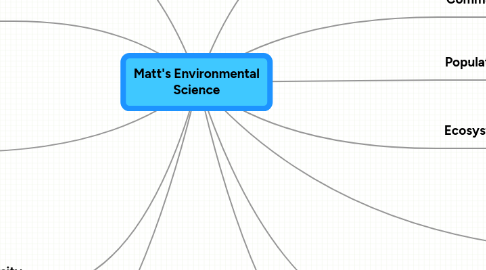Matt's Environmental Science
by Matt Bowman


1. Population Growth
1.1. Population Growth Rate
1.1.1. S-Curve
1.1.2. J-Curve
1.2. Exponential Growth
2. Trophic levels
2.1. Carrying Capacity
2.2. Food Web
2.3. Food Chain
2.4. Limiting Factors
2.5. Pioneer species
2.6. Producer
2.7. Primary Consumer
2.8. Secondary consumer
2.9. Tertiary Consumer
2.10. Decomposer
2.11. Biotic Factors
2.12. Abiotic Factors
2.13. Climax Community
3. Ecological Succession
3.1. Primary Succession
3.2. Secondary Succession
4. Biodiversity
4.1. Genetic Biodiversity
4.2. Species Biodiversity
4.3. Ecosystem Biodiversity
5. Water Pollution
5.1. Aquifer
5.2. Desalation
5.3. Water Purification
5.4. Watershed
5.5. Impermeable
5.6. Erosion
5.7. Runoff
5.8. Wetlands
5.9. Urbanization
5.10. Point Source
5.11. Non-Point Source
5.12. Organic Pollutant
5.13. Inorganic Pollutant
6. Biomes
6.1. Many ecosystems within a certain climate.
6.1.1. Rain Forests
6.1.2. Temperate deciduous forest
6.1.3. Coniferous forest
6.1.4. Desert
6.1.5. Tundra
6.1.6. Freshwater biome
6.1.7. Marine biome
6.1.8. Grassland/Savannah
7. Organisms
7.1. A single life form
7.1.1. A bear
7.1.2. A human
7.1.3. A insect
8. Population
8.1. A group of organisms
8.1.1. Bears
8.1.2. Humans
8.1.3. Insects
9. Community
9.1. Groups of different living organisms living together.
9.1.1. Bears, fish, deer
10. Ecosystem
10.1. A group of biotic and abiotic factors interacting in the same habitat.
10.1.1. The Jungle
10.1.2. Wetlands
10.1.3. A River
